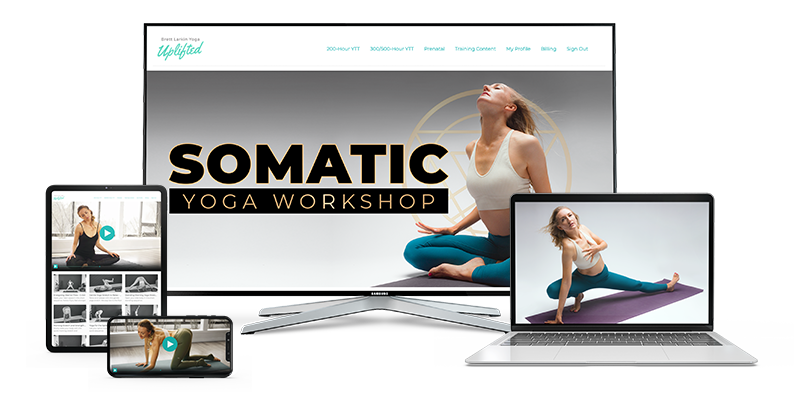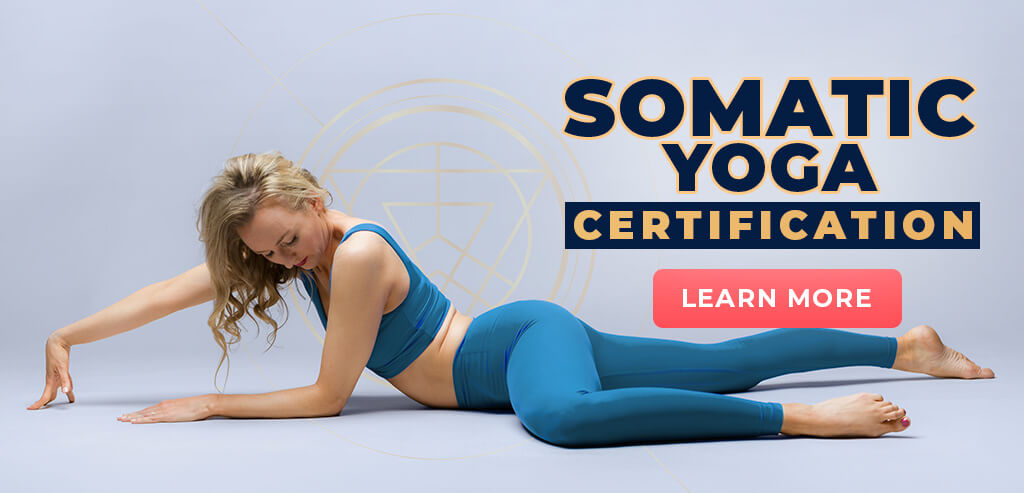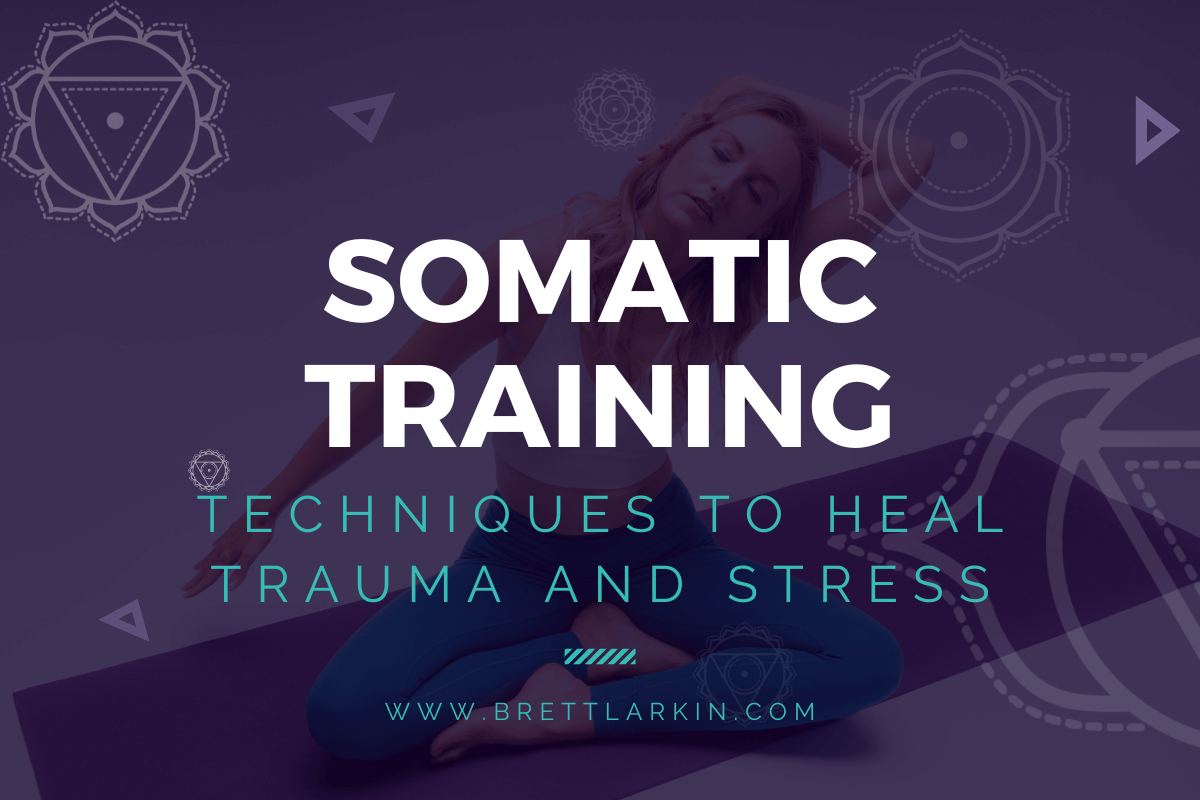For many people, they want to start healing trauma beyond the therapist’s couch.
Getting too stuck in the mind can sometimes be a hindrance to trauma recovery.
Somatic techniques have been proven to heal trauma, especially complex trauma. Somatic practices can help anyone release stuck stress and past stuck emotions.
If you’re curious to learn more or you’ve already dabbled in the world of somatic experiencing, then you might be interested in a somatic training program.
What Is Somatic Training?
Somatic training is a holistic approach that involves mindful movement and body awareness exercises designed to improve physical and emotional well-being. It’s based in neuroscience and it’s proven that through somatic experiencing, you can create new neural pathways. Essentially, you can rewire your brain! That’s why somatic therapy is excellent for trauma treatment.
Somatic training focuses on enhancing the mind-body-soul connection, reducing tension, healing trauma, and promoting relaxation through a variety of techniques such as somatic exercises, breathwork, and guided imagery. There’s even somatic psychotherapy, which integrates somatic practices with a clinical practice of psychotherapy.
If someone is displaying physical symptoms and/or trauma symptoms, then the best form of trauma treatment could be in healing complex trauma with somatics, or sensorimotor psychotherapy.
The truth is, we all have complex trauma from the collective trauma in the world. Many of us are operating from survival responses and stuck in old behavior patterns. We can pick up on vicarious trauma from others. When dealing with interpersonal neurobiology, we want to learn how to effectively deal with our nervous systems.
Somatic training is like a journey back to your true self. It’s about becoming embodied and learning to listen to your body’s signals while responding with compassion and care.
By engaging in somatic practices, you can release deep-seated tension, live more fully in the present moment, and increase your overall sense of vitality. Imagine moving through your day with greater ease and less pain, feeling more connected to your emotions and grounded in your physical presence.
When you decide to go more in depth in somatic therapy, you can empower individuals to find lasting healing too.
Somatic training isn’t just for those with chronic pain or stress; it’s for anyone looking to enhance their quality of life.
Whether you’re an athlete aiming to improve performance, a busy professional needing stress relief, or simply someone who wants to feel more at home in their body, somatic training offers valuable and effective tools and techniques. You might become a somatic experiencing practicioner, an embodied yoga teacher, or create your own stand alone business. Maybe you bring somatic training into your clinical work at your body work practice or use somatic approaches in your life coaching private practice. There are so many ways and practical tools to use somatic therapies.
Types Of Somatic Professionals
In the world of somatic therapy and somatic healing, there are so many different types of experts who are great at helping you get more in tune with your body.
First, you’ve got your somatic practitioners—these are the hands-on pros who can guide you through exercises and movements to release all that pent-up tension.
Then, you’ve got somatic teachers, who lead group classes where you can explore these techniques with others.
Need some one-on-one attention? That’s where somatic therapists come in, using therapeutic approaches to help you deal with stress, trauma, or pain.
And last but not least, there are somatic life coaches, your personal cheerleaders who’ll keep you accountable and help you integrate somatic practices into your daily routine.
So whether you’re looking for a group experience, some deep healing, or just a little extra support, there’s a somatic professional out there ready to guide you on your journey to feeling more connected and alive in your own skin. Each professional practice specializes in different somatic techniques.
If you’re interested in providing trauma informed care and gaining a deep understanding of somatic approaches, then you might want to pursue a training program.
Take my feminine energy quiz to get a recommended practice for balancing YOUR feminine energy 👇
Types of Somatic Trainings
So many somatic trainings exist. They each offer unique approaches to improving movement, body awareness, and overall well-being. I want to walk you through a few you might be familiar with or have heard of…
Feldenkrais
The Feldenkrais Method, developed by Moshe Feldenkrais, focuses on enhancing movement efficiency through gentle, exploratory movements and awareness practices. It emphasizes learning through movement variations and subtle shifts in body awareness to promote greater ease and flexibility.
Alexander Technique
In contrast, the Alexander Technique, founded by F.M. Alexander, centers on postural alignment, breath coordination, and mindful movement. It emphasizes releasing tension and improving posture through conscious attention to movement habits and principles of inhibition and direction.
Thomas Hanna Somatics
Thomas Hanna Somatics, developed by Thomas Hanna, integrates movement, awareness, and mindfulness to address chronic tension and enhance sensory-motor learning.
It emphasizes techniques such as pandiculation and somatic re-education to promote greater freedom and ease in movement patterns.
Embodied Yoga Life Coaching
This is the somatic certification program I created. It’s a life coaching certification rooted in yogic philosophy and paired with breathwork, yoga, cutting-edge somatic and embodiment practices, and nervous system regulation.
While each of these modalities share common goals of improving movement and body awareness, they differ in their underlying principles, techniques, and applications, offering practitioners a diverse range of approaches to somatic education and practice.
How To Become A Somatic Practitioner
There are so many different types of somatic modalities. However, the steps to practicing somatic therapy are all roughly the same:
Explore Somatic Techniques and Research Specialties
Begin your journey by exploring various somatic techniques and researching different specialties within the field.
Attend workshops, classes, or introductory courses to experience different somatic modalities firsthand. Take note of which approaches resonate with you and align with your interests and values.
You want to find a somatic experiencing practitioner you trust and test out this body oriented approach. An online course is a great way to test the waters.
Research the various specialties within somatic practices, such as somatic movement therapy, somatic experiencing, or body-mind centering, to determine which path you want to pursue in your somatic training journey.
Complete Specialized Training in Somatic Practices
The next step is to pursue specialized training in somatic practices through workshops, certification programs, or advanced courses. You can earn continuing education credits in many training programs.
Look for training programs that focus on somatic movement therapy, somatic experiencing, or other somatic modalities you’re interested in. These programs will deepen your understanding of somatic principles and provide you with practical skills to work with clients.
You’ll want to research as much detailed information about the program as possible before enrolling. Once you complete the program, you’ll be one of our new certified somatic therapy practitioners.
Experience My Somatic Yoga Workshop (usually $67) FREE!👇

Gain Practical Experience
Ideally, practice will be included in your somatic training. When you’re able to practice, your new skills are easily integrated into your healing therapy.
To become proficient as a somatic practitioner, gain hands-on experience by participating in internships, apprenticeships, or supervised practice opportunities.
Seek out mentors or experienced practitioners who can provide guidance and support as you apply somatic techniques in real-world settings.
Get Certified
Depending on the specific requirements of your state and professional field, you may need to obtain certification or licensure to practice as a somatic practitioner.
Research the certification or licensure requirements in your area and ensure that you meet all necessary criteria, which may include completing a certain number of training hours, passing exams, and fulfilling supervised practice hours.
Commit to Continuing Education and Professional Development
The great thing about trauma treatmetnt and somatic experiencing is that there are always new techniques emerging. Stay current with advances in the field of somatic practices and trauma healing by engaging in ongoing continuing education and professional development.
Attend workshops, conferences, and advanced training programs to expand your knowledge and skills, and stay connected with other somatic practitioners to exchange ideas and resources.
In fact, developing a cohort of other trusted practitioners will help you gain a deeper understanding of your own practice.
Continued learning and growth are essential for maintaining competence and effectiveness as a somatic practitioner throughout your career.
How To Choose The Right Somatic Training For You
Choosing the ideal somatic training program involves considering your professional background, personal interests, and desired outcomes. Here’s a tailored guide to help you navigate your options:
- Identify Your Goals: Determine your specific goals and interests in somatic training. Are you looking to deepen your understanding of movement, enhance your teaching skills, or integrate somatic principles into your therapeutic practice?
- Research Training Modalities: Explore different somatic training modalities. Learn about the principles, techniques, and applications of each modality to see which aligns best with your goals and values.
- Attend Introductory Workshops or Courses: Attend introductory workshops or courses for each training modality you’re considering. This hands-on experience will give you a taste of the teaching style, approach, and philosophy of each program.
- Connect with Instructors or Alumni: Reach out to instructors or alumni of the training programs you’re interested in. Ask questions about the curriculum, teaching methodology, and post-training support to gain insights into what to expect from each program.
- Consider Your Learning Style: Reflect on your preferred learning style and environment. Do you thrive in a structured classroom setting, or do you prefer self-paced online learning? Or maybe a hybrid of both? Choose a training program format that suits your learning preferences and lifestyle.
- Evaluate Program Accreditation and Certification: Research the accreditation and certification of each training program to ensure it meets industry standards and aligns with your professional goals. Look for programs that are recognized by reputable organizations and offer certification upon completion.
- Assess Program Cost and Time Commitment: Consider the cost and time commitment required for each training program, including tuition fees, travel expenses, and time away from work or other commitments. Choose a program that fits within your budget and schedule constraints.
- Trust Your Intuition: Ultimately, trust your intuition and choose the somatic training program that resonates most with you. Listen to your instincts, consider all factors carefully, and select the program that feels like the right fit for your personal and professional journey.
What is Somatic Yoga – 5 Min Explainer Video 👇
Choosing the Right Somatic Training: Recommendations for Professionals
Embarking on a journey to select the ideal somatic training program can feel like navigating a labyrinth of options.
Whether you’re a mental health professional seeking to integrate somatic approaches into therapy or a yoga teacher looking to deepen your understanding of embodied movement, finding the right fit is essential for your growth and development. Maybe you even want to complete an integrative somatic practitioner certification. The options for trauma treatment and somatic therapies are endless.
I have some tailored recommendations for different types of professionals, helping you navigate the diverse landscape of somatic training modalities with clarity and confidence.
Mental Health Professionals
If you’re a mental health professional, such as a counselor or therapist, seeking to integrate somatic approaches into your practice, explore training programs that blend psychotherapy with somatic techniques.
Look for certifications or workshops in somatic experiencing, body-oriented psychotherapy, or trauma-informed care.
These programs will equip you with valuable tools to address trauma, regulate the nervous system, and promote trauma healing through embodied practices.
Yoga Teachers
For yoga teachers aiming to deepen their understanding of embodied movement and refine their teaching skills, consider somatic experiencing programs rooted in movement education and experiential anatomy.
Explore certifications or workshops with a balance between yogic philosophy and somatic knowledge.
These programs offer innovative approaches to movement re-education, enhancing your ability to cue movement effectively and support students in cultivating greater body awareness and resilience.
Occupational Therapists
Occupational therapists looking to incorporate somatic principles into their practice can benefit from training programs that focus on functional movement, sensory integration, and holistic health.
Seek out certifications or workshops that emphasize hands-on techniques, movement re-patterning, and client-centered care.
Personal Trainers and Bodyworkers
If you’re a personal trainer or bodyworker interested in expanding your skill set and offering more holistic services to your clients, explore somatic training programs that integrate movement re-patterning and pain management techniques.
These programs will complement your existing practice and provide you with new tools to help clients move with greater ease and efficiency.
When selecting a somatic experiencing training program, take the time to research different options, attend introductory courses or workshops, and connect with instructors or alumni to gain insights into the program’s approach and philosophy.
Trust your intuition and choose a program that aligns with your values, resonates with your interests, and supports your professional growth as a somatic practitioner.
Final Thoughts
Navigating the world of somatic therapy can be an enriching and transformative journey. By carefully considering your goals, researching different modalities, and trusting your intuition, you can find the perfect fit to support your professional growth and personal development.
Whether you’re a mental health professional seeking to integrate somatic approaches into therapy, a yoga teacher looking to deepen your understanding of embodied movement, or someone simply curious about exploring new avenues of self-discovery, there’s a somatic therapy program out there waiting for you.
Remember, the key is to approach the process with an open mind and a willingness to explore. Embrace the opportunity to learn from experienced instructors, connect with like-minded peers, and delve into the rich tapestry of somatic practices.
With dedication, curiosity, and a commitment to lifelong learning, you can embark on a journey of transformation that extends far beyond the confines of the yoga mat, enriching your practice, and enhancing your life – and the lives of your clients – in unexpected ways.
Next Steps
- Take a deep dive into embodiment and somatic yoga with my Somatic Yoga certification program.
- If you’re interested in practical kriya yoga as a way to improve your daily life and relationships, check out my Yoga for Self Mastery course.

FREE Embodied Yoga Workshop (usually $67) Somatic Techniques & Cord Cutting Ritual

YOU MIGHT ALSO LIKE
- 6 Effective Somatic Yoga for Neck and Shoulders
- How to Teach Somatic Yoga: A Practical Guide for Instructors
- The Best Somatic Exercises for Grief: Find Healing Through Movement
- The Best Somatic Exercises for Anger Management and Emotional Release
- How to Teach Somatic Yoga to Beginners
- Best Somatic Yoga Poses for Emotional Release and Healing
- The Rich History of Somatic Yoga: From Origins to Modern Practices
- Somatic Yoga for Stress: Effective Techniques to Find Calm and Relief
- The Perfect Yoga Practice For Your Menstrual Cycle Energy Levels
- Enhancing Your Practice: The Benefits of Yoga and Nature Connection
- Gentle Somatic Yoga for Back Pain: Relief and Prevention Techniques
- How Somatic Yoga for Anxiety Can Help You Find Calm and Balance
- Somatic Stress Release Techniques for Emotional Balance
- Progressive Muscle Relaxation Meets Yoga for Deep Sleep
- 5 Somatic Hip Exercises For Beginners









